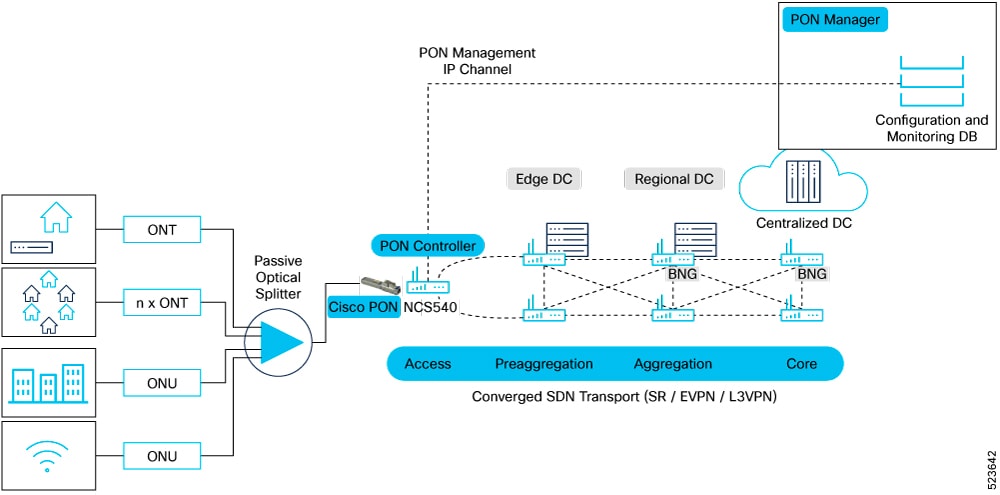Release Notes for Cisco Routed PON Solution, Release 24.1.1
The release notes provides an overview of the Cisco Passive Optical Network(PON) solutions, its features and also lists the caveats.
Cisco Routed PON Overview
With the advancements in broadband technology, the customer demands have expanded to high-resolution audio and video playback, seamless audio and video streaming, immersive Virtual Reality (VR) experiences, and responsive gaming. These technologies require high bandwidth with low latency to function smoothly. Today this is achieved with the help of a large Optical Line Terminal (OLT) chassis that connects at the access layer within the network infrastructure.
Cisco Routed PON Solution is a transformational approach that condenses the OLT chassis into a pluggable form factor. The solution becomes a part of the access router by plugging the Cisco PON SFP+ into 10G ports of NCS540, NCS5500, and NCS5700 series routers. You have the option to use a scalable model based on your bandwidth requirements, choosing between PON pluggable optics or Ethernet optics for your requirements.
The Cisco Routed PON eliminates the dedicated PON chassis, which removes vendor lock-in due to proprietary hardware and software. The OLTtranceiver SFP not only costs less than the PON chassis, but also doesn’t require additional power supply and rack space. This solution enables you to adopt a scalable 'pay-as-you-grow' approach, allowing you to incrementally select and add the necessary hardware enhancements to accommodate your increasing bandwidth requirements over time. Some other benefits of the Cisco Routed PON solution are:
-
Compatible with nonproprietary ONTs
-
Enhanced income generation through a network focused on service delivery
-
Accelerated deployment of new services to the marketplace
-
Maximized efficiency in fiber bandwidth usage
This release supports the PON Controller on the following Cisco router variants:
-
N540-24Z8Q2C-SYS
-
N540-ACC-SYS
-
N540X-16Z4G8Q2C-A, N540X-16Z4G8Q2C-D
-
N540-28Z4C-SYS-A, N540-28Z4C-SYS-D
-
N540-24Q8L2DD-SYS
-
NCS-55A1-24Q6H-SS
-
NCS-55A2-MOD-S
-
NCS-57C1-48Q6D
Cisco Routed PON Architecture

As shown in the illustration, the Cisco PON pluggable OLT is inserted into the SFP+ ports on the routers. The PON Manager is a Graphical User Interface (GUI) web page used to provide a user-friendly interface for monitoring and managing the network. The PON controller provides a secure communication channel between the PON manager and the OLTs and ONUs. These three components of the solution are discussed in detail below.
Components of the Cisco Routed PON Solution
The various components of the PON solution are:
Cisco PON pluggable OLT - The Cisco PON pluggable OLT is designed for software-defined broadband network deployment and comes in a hot-pluggable SFP+ form factor. This module is equipped with an integrated chip that enables connection from a PON network to a point-to-point Ethernet SFP+ port located on routers. It supports symmetric 10G upstream and downstream rates.
Cisco PON Controller - The Cisco PON controller serves as a device driver and management application that is stateless, tasked with the configuration and supervision of endpoints within a PON network. This lightweight application is deployable as a Docker container and is compatible with the NCS540, NCS5500, and NCS5700 series routers.
Cisco PON Manager - The Cisco PON manager consists of a web-based application along with an associated REST API, which together offers a graphical user interface to oversee the PON network. The REST API is designed to facilitate access to MongoDB, enabling the management of both PON users and the PON network.
MongoDB database - The MongoDB database stores and manages the configuration and operational state of the PON network. MongoDB acts as a middle layer between the PON Manager and the PON Controller. The REST API provided by the PON Manager is designed to facilitate access to the operational state maintained in MongoDB, thus enabling the management of both the PON subscribers and the PON network.
Hardware Introduced
The following new hardware is introduced for this release:
|
Hardware |
Description |
|---|---|
|
Cisco PON OLT SFP |
This release supports configuration and management of the Cisco PON 10G OLT SFP+ transceiver on the following Cisco NCS 540, 5500, and 5700 Series Routers:
The transceiver module plugs into the 10G port on the Router. The combination of the tranceiver, PON Manager, PON Controller, and the MongoDB creates a network management solution for monitoring and managing OLTs and ONU devices in the network. With the help of the transceiver, the router functions as an OLT, this removes the requirement of a separate OLT Chassis. |
Restrictions and Limitations on the Cisco Routed PON Solution
-
IEEE 802.1X (Dot1x) authentication isn’t supported for the Cisco OLT interface.
Caveats
|
Bug ID |
Headline |
|---|---|
|
PON ONU’s may not get detected post software activation |
Related Documentation
The documentation related to installation and management of the Cisco Routed PON Solution is as follows:
|
Document Name |
Description |
|---|---|
| Refer to this document understand and deploy the Cisco Routed PON solution. | |
|
Refer to this document to install the various components of the Cisco Routed PON solution such as the PON Manager, the MongoDB database, and the PON Controller. This document also contains various sizing requirements for the components along with the complete steps to install the components. |
|
|
Refer to this document to understand the configuration, security features, and usage information for the PON Manager. |
|
|
Refer to this document to understand the architecture and design of the Application Programming Interface (API), the structure of the REST endpoints, request, and response formats, and reference and usage information for the REST API. |
 Feedback
Feedback